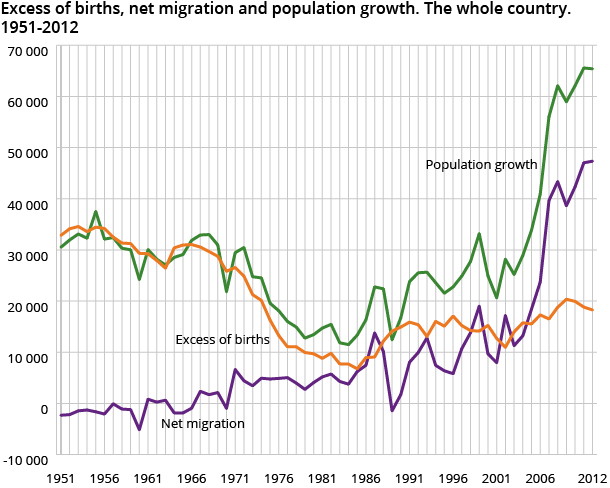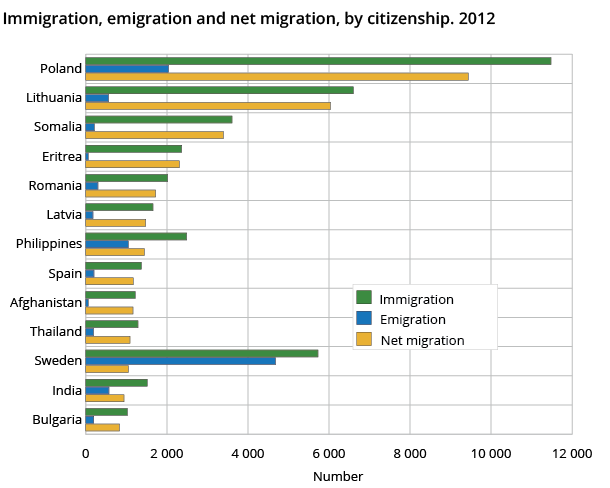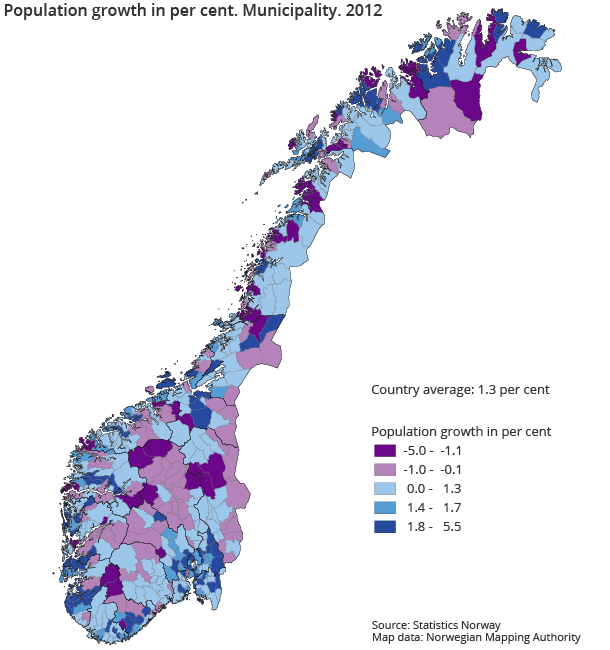Content
Published:
This is an archived release.
Still high population growth
At the beginning of the year, there were 5 051 300 residents in Norway, giving a population growth of 65 400 in 2012. Immigration surplus accounted for 72 per cent of the growth.
| 4th quarter 2012 | 4th quarter 2011 - 4th quarter 2012 | ||
|---|---|---|---|
| Number | Per cent | ||
| Population at the beginning of the quarter | 5 038 137 | 65 108 | 1.3 |
| Births | 13 721 | -62 | -0.4 |
| Deaths | 10 713 | 178 | 1.7 |
| Excess of births | 3 008 | -240 | -7.4 |
| Immigration | 18 616 | 1 430 | 8.3 |
| Emigration | 8 322 | 996 | 13.6 |
| Net migration, immigration and emigration incl | 10 294 | 434 | 4.4 |
| Population growth | 13 138 | 297 | 2.3 |
| Population at the end of the quarter | 5 051 275 | 65 405 | 1.3 |
The population growth of 1.3 per cent in 2012 was the highest since 1920 with the exception of 2011. In Europe, Norway is among the nations with the highest population growth percentage wise. In the six years 2007-12 the population increased by 370 100, more than twice the number of the previous six years.
Highest ever net migration from abroad
Net migration from abroad reached 47 300 in 2012, an increase by 300 from 2011 to 2012, and has never been higher. During the last six years, net migration from abroad has totalled 258 400, almost three times the number of the previous six year period. There were 78 600 registered migrations to Norway from abroad in 2012, a decrease of 900 from the previous year. A total of 31 200 people left the country, about 1 200 fewer than last year. People staying in Norway for a shorter period than six months are not registered and not included in these figures.
Somewhat lower fertility rate, increased life expectancy for males
There were 60 250 children born in 2012, just 35 more than in 2011. A total of 42 000 persons died, 600 more than in 2011. The excess of births still remains on a high level as lasting previous years. The excess of births was highest in Oslo.
Total fertility rate for 2012 was 1.85, while the rate for 2011 was 1.88 and for 2010 1.95. Even with this slight decrease, Norway still ranks among the countries in Europe with the highest fertility rates.
A boy born in 2012 has a life expectancy of 79.4 years up from 79.0 in 2011, while a girl can expect to become 83.4 years, the same as in 2011.
Decreasing immigration from Europe, increasing particularly from Africa
Net migration from abroad by foreign citizens increased from 47 900 in 2011 to 48 700 in 2012. Of this, 30 900 or 63 per cent, was net immigration of European citizens. In 2011 the figure was higher at34 700. The net migration of non-European citizens increased from 13 200 in 2011 to 17 800 in 2012, an increase of 35 per cent.
The largest surplus still consists of citizens from Poland and Lithuania, constituting half of the European immigrants to Norway. Six of the 11 countries with a net immigration of more than 1 000 are European. Net migration of Spanish citizens increased from 800 in 2011 to 1 200 in 2012. Net migration of Somali citizens increased from 1 450 in 2011 to 3 400 in 2012, constituting the third largest group.
Highest population growth in Oslo, Akershus and Rogaland
Oslo and Akershus were the counties with the highest population growth in 2012, with a total of 20 800. That is 4 000 fewer than last year. The population in Rogaland and Hordaland grew by 16 600, 3 200 more than the previous year. All counties had a net immigration in 2012. The largest, in real figures, was in Akershus.
Net immigration from abroad was particularly high in two parts of the country. Rogaland and Hordaland with 10 900 had the largest, up from 8 200 the previous year. Oslo and Akershus followed with 10 600, down from 14 300 last year. Seven counties had a domestic net immigration.
Population grew in 311 municipalities, whereas 114 experienced a decrease. 219 municipalities had a birth surplus, whereas 203 had a deficit. As for domestic migration, 172 municipalities had a surplus and 253 a deficit. Among the municipalities with the largest deficit, many were situated in the Northern part of Norway.
About advance releasesOpen and readClose
More detailed statistics on births, deaths, internal migrations, immigration and emigration, marriages and divorces will be published on 11 April, 2 May and 22 August respectively.
The statistics is published with Population.
Contact
-
Statistics Norway's Information Centre
E-mail: informasjon@ssb.no
tel.: (+47) 21 09 46 42




